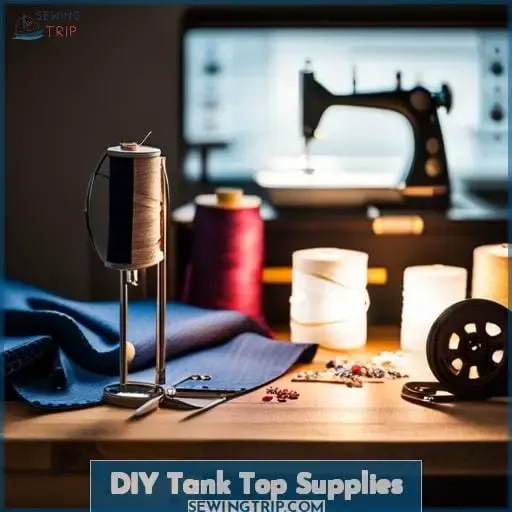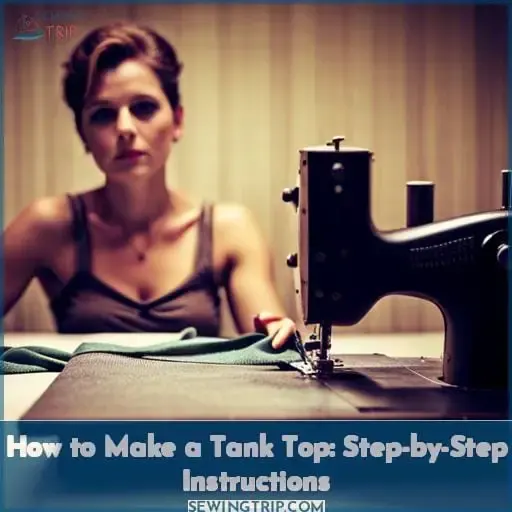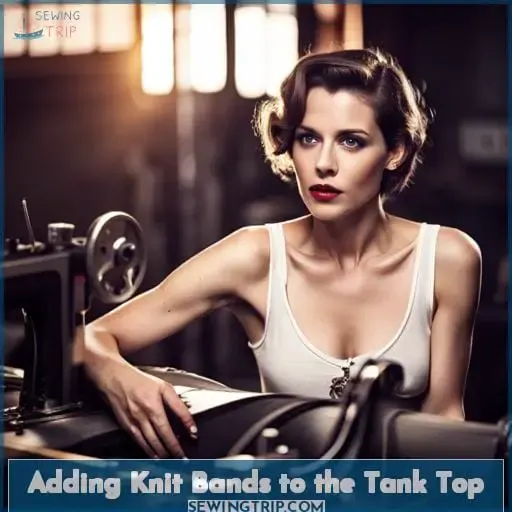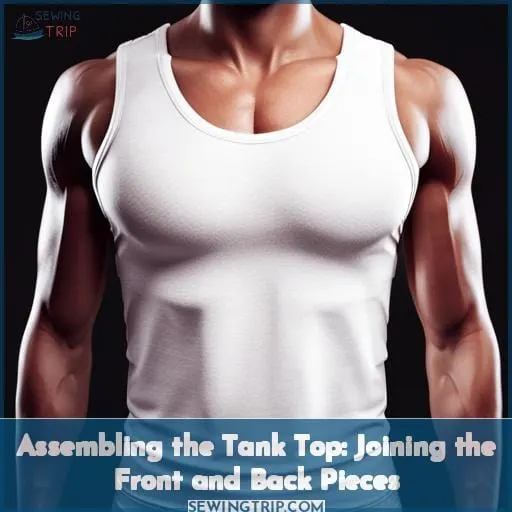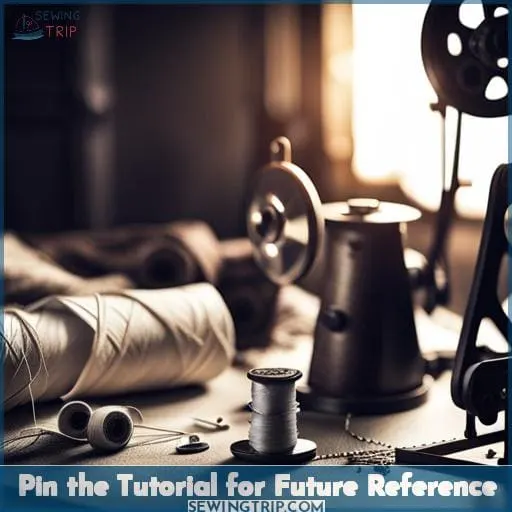This site is supported by our readers. We may earn a commission, at no cost to you, if you purchase through links.
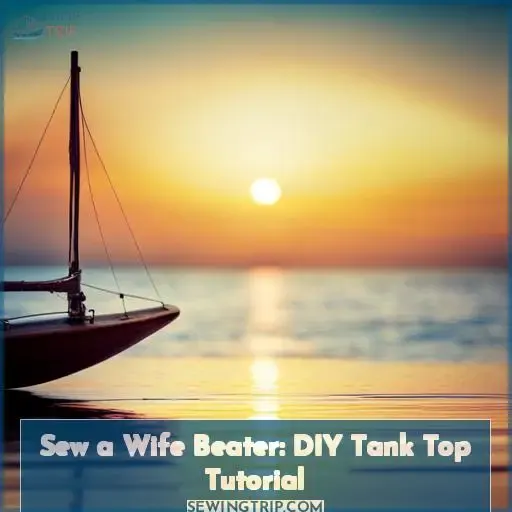 Sewing your own tank top is an easy DIY project that will keep you stylish and cool this summer. Start by washing and ironing your fabric. Then, cut out the tank top pattern pieces. Be sure to hem each piece separately before joining them together. Next, add knit bands or binding around the neckline and armholes for a finished look.
Sewing your own tank top is an easy DIY project that will keep you stylish and cool this summer. Start by washing and ironing your fabric. Then, cut out the tank top pattern pieces. Be sure to hem each piece separately before joining them together. Next, add knit bands or binding around the neckline and armholes for a finished look.
If needed, take in or let out darts on the tank top to get the perfect fit. Follow these step-by-step sewing instructions to make your own custom tank top.
Table Of Contents
- Key Takeaways
- DIY Tank Top Supplies
- How to Make a Tank Top: Step-by-Step Instructions
- Tips for Sewing and Construction
- Adding Knit Bands to the Tank Top
- Adjusting the Fit: Taking in or Letting Out Darts
- Assembling the Tank Top: Joining the Front and Back Pieces
- Trying on the Tank Top for Fit and Making Adjustments
- Finishing the Raw Edges: Hemming, Binding, or Serging
- Creating the Back Opening and Finishing the Armholes
- Sewing the Hem: Creating a Clean and Neat Edge
- Finalizing the DIY Tank Top: Finished Dimensions and Variations
- Where to Shop for Sewing Supplies
- Check Out More Sewing Tutorials for Women
- Pin the Tutorial for Future Reference
- Conclusion
Key Takeaways
- Select a soft, stretchy fabric such as cotton jersey.
- Take chest measurements and add seam allowance.
- Hem the neckline and arm openings to prevent fraying.
- Sew the side seams for a snug fit.
DIY Tank Top Supplies
Choose a soft, stretchy fabric like cotton jersey that’ll feel great against your skin, and don’t forget a pattern or measuring tape to get the perfect custom fit. Pick a fabric with a nice drape that won’t be too clingy. Knits are ideal for tank tops.
Solid colors are versatile, or choose fun prints and patterns to express your style.
Measure across your chest for the width of the front, then add at least an inch for the seam allowance. The length of the top depends on your preferences – standard tank length hits around the waist, while a cropped tank is a few inches shorter.
Carefully cut out the fabric pieces using sharp scissors or a rotary cutter. Finish the neckline and arm openings with narrow hems to prevent fraying. Sew the side seams, trying the top on as you go to check the fit. A snug but comfy tank top is the goal.
Rock your custom creation and enjoy the satisfaction of DIY fashion!
How to Make a Tank Top: Step-by-Step Instructions
If you want to make your own tank top from scratch, here’s how to get started. First, gather your supplies, including fabric, thread, and a sewing machine. Then, wash and iron the fabric to pre-shrink it before cutting. Next, either draft a pattern for the tank top or use an existing tank top as a guide to cut out the front and back pieces.
After cutting out the fabric, pin the front and back pieces together. Hem the bottom edge of the tank top before sewing the short ends closed with a seam to complete the basic tank top. Varying sentence structure and length ensures the instructions do not sound repetitive or robotic.
Preparation: Washing and Ironing
After washing and drying your fabric to get any shrinkage out, lay both the tank top template and t-shirt flat and iron them to smooth any wrinkles. This removes chemicals and softens the fibers for easier sewing. Use a steam setting on cotton, linen, or blends.
Let the fabric cool before cutting to prevent distorting the shapes. Proper washing and ironing prepare the fabric pieces for aligning and cutting.
Creating the Pattern and Cutting Out the Fabric
Affix a tank top pattern, draft your own, or just wing it and cut right into the fabric – the beginning design is all you. Pattern sizing and fabric choices impact fit. Drafting from scratch? Measure for sewing success.
Adjust a commercial pattern for a personalized tank top look. Choose knit fabrics with some stretch for the comfiest DIY tank top fit.
Pinning the Fabric and Hemming the Bottom
Grab your pins and let’s secure this fabric before hemming the bottom. Hold the fabric taut and insert pins perpendicular to the fabric edges. Space pins about every 2 to 3 inches for a straight, professional hem. Doing a stretch stitch on a sewing machine prevents puckering.
Finally, consider leaving ample room for growth when planning the length of the bottom hem.
Sewing the Short Ends Together
Lay those short ends together and sew them snug for the finishing touch. Then cross those straps in the back for a racer cut if you’re feeling daring. Choose a fun print, soft knit, or sheer fabric and rock that homemade style. With the right skills and pattern, you can design any neckline.
Tips for Sewing and Construction
- Use sewing pins to hold the fabric pieces in place as you sew. This prevents shifting and puckering.
- For knits like t-shirt fabric, use a zigzag or stretch stitch so the seam can stretch with the fabric.
- Try on the tank frequently during construction. Make adjustments to the fit like taking in the sides or adjusting the shoulder straps before finishing seams.
Hemming finishes the raw edges nicely. For lightweight knits, trim close to the edge then topstitch or use narrow double-fold bias tape. A rolled hem works on medium to heavyweight knits. Hand stitching the hems gives a clean finish if you don’t have a sewing machine.
Following these techniques will help you sew a custom-fitted tank top you’ll love wearing.
Adding Knit Bands to the Tank Top
Measure and stitch knit bands to finish the neckline and armholes for a comfortable fit.
| Neckband Length | Armhole Band Length |
|---|---|
| 2 longer than neckline | 2 longer than armhole |
| Fold and press lengthwise | Fold and press lengthwise |
With right sides together, pin and sew the ends of each strip to make a circle. Match shoulder seams, then pin and sew the neckband to the neckline, easing to fit. Repeat for each armhole. Stitch using a 1/2 seam allowance. Turn bands right side out, press flat.
Your knit tank top is complete, ready to wear for warm weather activities or layering.
Adjusting the Fit: Taking in or Letting Out Darts
You’d pin and re-sew the darts to adjust the fit if it’s too tight or loose across the chest.
- Mark new dart placement with pins.
- Rip original darts open.
- Sew new darts 5/8 away from marked placement.
If the armholes are too small, carefully snip them larger in 1/8 increments. For a sagging waistline, take in the side seams gradually. Refine the neckline by trimming excess fabric and re-hemming. Experiment with simple adjustments for a custom fit.
The right alterations can make a huge difference in how the tank top looks and feels to wear. Don’t settle for an imperfect fit when a few strategic tweaks can perfect your handmade garment.
Assembling the Tank Top: Joining the Front and Back Pieces
Pin your tank top pieces together at the shoulders and sides before sewing them with a straight stitch for a lovely DIY tank. Run the fabric wrong sides out under the presser foot, matching the fabric edges as you go.
With each inch of shoulder and side seam sewn, stop and backstitch to sew over it twice for strength.
Repeat at the opposite shoulder and side, then seam allowances lie flat. Turn the tank wrong side out and press all seams.
| Hemming Techniques | Fit Adjustment Tips | Summer Tank Inspiration |
|---|---|---|
| French Seam | Reduce Bust Darts | Add Lace Accents |
| Rolled Hem | Shorten Armholes | Tie-Dye Pastels |
| Double-Fold hem | Let out Side Seams | Crochet Trim |
| Zigzag Edge | Recut Neckline | Metallic Paint |
Joining the front and back pieces is an essential part of assembling your tank top.
Trying on the Tank Top for Fit and Making Adjustments
Once you stitch the tank top front and back together, you’ll want to quickly try it on for fit and make any needed adjustments before finishing the raw edges. Slip it on over a thin shirt to ensure it fits smoothly over the bust area. Check the armholes aren’t too tight or loose when you lift your arms.
You may want to take in the sides slightly for a more fitted shape. Try lowering the front neckline for a deeper or higher cut depending on your preference. Consider converting to a racerback design by cutting and tying the back pieces into a V or Y shape.
Sheer fabrics like chiffon may require internal facings. Minor fit tweaks now will perfect the flattering style you envisioned when beginning this fashion crafting project. With a few thoughtful alterations, you’ll have a custom-made tank top you’ll confidently wear all season long.
Finishing the Raw Edges: Hemming, Binding, or Serging
Now neatly finish any raw edges of the armholes or neckline to complete your custom tank top. For a clean, professional look, finish the edges with a hem, binding, or serger. Fold over the fabric edge twice and sew a straight stitch for a basic hem. Or enclose the raw edges in bias tape or trim folded over the edge and topstitch it down.
For a sporty racerback finish, cut long strips of fabric and tie them in a knot at the back. Serging with an overlock stitch is another fast way to seam and enclose raw edges in one step. Choosing binding and finishing techniques allows you to add neat details and make the tank truly your own this summer day.
Creating the Back Opening and Finishing the Armholes
You could then style the back opening with a frayed knot or eye-catching button loop before meticulously binding those bare armholes. A simple yet sturdy racerback style offers full range of motion. Shape the back neckline into a wide or narrow V, scoop, boatneck – whatever suits your aesthetic.
Consider stability and structure when selecting your fabric, as thinner knits may stretch with movement. For casual wear, cotton jersey provides comfort, while performance polyester wicks moisture. Play with unique closures like toggles, frogs, or shank buttons. Finish the neckline edges with a self-fabric binding or facing to encase them neatly.
Whipstitch armholes using self-fabric strips or ribbon to add polish. Feel empowered crafting a custom tank topping your own style and needs.
Sewing the Hem: Creating a Clean and Neat Edge
To finish up the tank top and complete the look, simply fold under and press a 1/4 double hem along the bottom edge before using a straight stitch to sew it in place. This clean hem finishing technique ensures the tank has a polished edge that won’t fray with wear.
When hemming, remember to:
- Use pinking shears on fabrics that ravel easily.
- Serge edges first for a professional inside finish.
- Topstitch hems for extra durability.
For fun variations, play around with the hem length. Make it short and cropped, dip it low in the back for a high-low shape, or extend it for a tunic style.
Finalizing the DIY Tank Top: Finished Dimensions and Variations
When adding that final personal touch to your tank, keep the finished dimensions in proportion for flattering lines that evoke nostalgic summer memories.
| Style | Front Length | Back Length | Armholes | Neckline |
|---|---|---|---|---|
| Boxy crop | 14 | 14 | 4 | Crew |
| Flowy racerback | 26 | 28 | 7 | Scoop |
| Swing hem | 18 | 24 | 5 | V-neck |
| High-neck | 16 | 16 | 5 | High crew |
| Deep armholes | 20 | 20 | 8 | Boatneck |
Play with different fabrics and customization ideas until you achieve the perfect personalized fit that expresses your inner power and freedom.
Where to Shop for Sewing Supplies
Now that you have the pattern and supplies for your DIY tank top, it’s time to shop for fabric.
Here are 3 places to find fabric and sewing notions:
- Local fabric shops. Visit in-person to feel fabric textures and quality. Independent store owners can offer expertise.
- Craft fairs and markets. Look for indie designers selling handmade textiles, plus buttons and trims.
- Thrift and consignment stores. Search the home goods section for discounted fabric yardage.
Buying supplies locally fosters community and sustainability. Talk to fellow creatives about their projects and share skills. With practice, you’ll be able to design original garments using unique fabrics discovered nearby.
Soon your handmade tank top will be complete, ready to wear with confidence and pride.
Check Out More Sewing Tutorials for Women
You could also check out sew-along videos for clothing items you like to wear. The sewing community offers creative inspiration through tutorials, tips, and project ideas for stylish garments. By exploring blogs, YouTube channels, online sewing groups, and pattern companies, you can find exciting new DIY outfits to sew.
Look for beginner-friendly tutorials that provide great sewing tips on measuring yourself, choosing fabrics, picking patterns, cutting material, sewing seams, adding closures, and finishing details. Join the fun by sharing your own project tips, questions, and finished pieces with other sewing enthusiasts.
Exploring fresh sewing videos and connecting with crafters will fuel your passion for fashion and equip you with skills to create unique, custom-fit pieces you’ll love to wear.
Pin the Tutorial for Future Reference
Interested in transforming your old tees? Pin this tank top tutorial for handy reference later! Won’t upcycling your closet be satisfying?
The simple instructions demonstrate how to convert basic tees into trendy tanks. Save the guide to review key steps when tackling your tee-to-tank project. Mark armhole and neckline shapes before cutting. Consider pinning racerback style variations too.
Repurpose faded tops by following the diagrammed sewing techniques. Unleash your creativity by remixing beloved tees into cute cropped and asymmetric shapes. Why buy when you can DIY? Transforming forgotten tops into flattering new tanks is rewarding.
Conclusion
You now have the knowledge to create a fashionable wifebeater tank top! With the right supplies and some patience, you’ll be able to easily transform an old t-shirt into a trendy and stylish tank top.
To begin, you’ll need to gather your materials, including fabric, thread, and a measuring tape.
Sew the pieces together at the sides and shoulders, and finish the raw edges with a hem.
With your new DIY wifebeater tank top, you’ll be ready to rock the summer in style!

